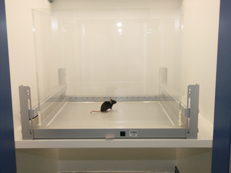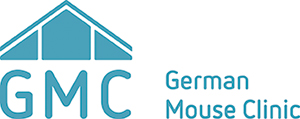Technologies
Open Field (TSE, Bad Homburg)

The Open Field test explores spontaneous locomotor activity and anxiety-related behaviour in a novel environment. The apparatus we use is located in a square-shaped (XY) frame equipped with two pairs of light-beam strips (16 x 16 infrared sensors) to measure activity levels and the location of the exhibited activity by recording the beam breaks caused by the animal. Rearings are measured by a further pair of light beam strips detecting movements in the Z-axis. The data is recorded by a computer, which scans the sensors with a frequency of 100 Hz.
Acoustic Startle Chambers (Med Associates Inc., VT, USA)
We assess sensorimotor gating by measuring Pre-Pulse Inhibition of the Acoustic Startle Reflex. Pre-pulse inhibition is considered to have face, construct, and high predictive validity for schizophrenia and other neuropsychiatric dysfunctions involving alterations in sensorimotor integration in man. The apparatus consists of a sound-attenuating cubicle, high-quality loud speakers, a load cell platform and a computer for stimulus presentation and data collection.
Ethovision and Observer software (Noldus, Wageningen)
For many tests, e.g. Elevated Plus-Maze, Forced Swimming, Social Discrimination, Social Interaction, Y-maze or Object Recognition, we use the Ethovision video-tracking system to record an animals locomotor path and a hand-held computer equipped with the Observer software to observe and manually record an animals behaviour in the respective test situations.
IntelliCage (New Behavior/TSE, Bad Homburg)

The IntelliCage can be used to assess learning and memory or motivation in group-housed mice in their home cage. Each mouse is tagged with a tiny transponder, through which its access to the drinking bottles in the four corners of the IntelliCage can be individually controlled and monitored. By using the software to design place learning, reversal learning or more complicated tasks, the animals’ learning curves or motivation can be measured over weeks with minimal experimenter interference for cage cleaning and bottle refilling.
Running Wheels (Med Associates Inc., VT, USA)
We use these running wheels in the home cage to assess the animal’s voluntary running activity. The wheels can easily be cleaned, and the base works with Bluetooth technology, avoiding any problems with cables. The wheel manager software allows the continuous recording of running activity, enabling analysis of running duration, speed and circadian rhythms. This method can be used to phenotype mutants with suspected alterations in activity levels, e.g. due to locomotor or metabolic disturbances, or as a challenge to induce adult neurogenesis. It can also easily be combined with other measurements, e.g. indirect calorimetry.
CatWalk (Noldus, Wageningen)
The CatWalk can be used to analyse the gait of mice voluntarily running down the glass walkway. A camera situated in the middle underneath the glass walkway records the animal’s footsteps and the software allows the measurement of over 200 gait parameters. This method can be helpful to detect early phenotypes in genetic mouse models of locomotor diseases, and to monitor disease progression or effectiveness of therapeutic interventions.

